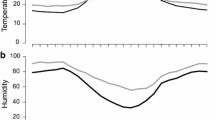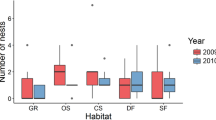Abstract
We examined the recruitment rate of nestmates during prey capture in six arboreal ant species: Myrmicaria opaciventris, Platythyrea conradti, Crematogaster sp., Crematogaster clariventris, Tetramorium aculeatum, and Oecophylla longinoda. Termites and grasshoppers were used as prey. Prey were grouped by size: for termites, we presented ants with either workers or soldiers and for grasshoppers, we used small nymphs, mature nymphs and adults. After prey detection by a foraging ant, the total recruits present were counted every 30 s over the course of 15 min, and the mean numbers of workers counted at each time interval was computed and plotted for each prey type. We tested the effect of prey type, prey size and termite caste for each ant species on the number of nestmates recruited using ANOVA (GLM proc). Prey size, prey type and termite caste significantly influenced the mean number of nestmates following initial prey detection. We found that the observed recruitments were well explained by linear models for less arboreal (M. opaciventris) and primitive arboreal species (P. conradti), reflecting stochastic movement by individuals or stochastic collective recruitment. For specialized arboreal ant species, recruitment was well explained by exponential models, reflecting within-group recruitment, either with limited or with unlimited group sizes. Overall, T. aculeatum had the highest level of nestmate recruitment. Surprisingly, O. longinoda, known to be one of the most specialized arboreal ant species, fit a recruitment model more like that of either ground ants with some arboreal foraging habits or primitive arboreal species.







Similar content being viewed by others
References
Amor F, Ortega P, Cerda X et al (2010) Cooperative prey-retrieving in the ant Cataglyphis floricola: an unusual short-distance recruitment. Ins Soc 57:91–94
Bonabeau E, Theraulaz G, Deneubourg JL (1998) Group and mass recruitment in ant colonies the influece of contact rates. J Theo Biol 195:157–166
Dejean A (1988) Prey capture by Camponotus maculatus (Formicidae-Formicinae). Biol Behav 13:97–115
Dejean A (1990) Prey capture strategy of the african weaver ant. Westview Press Boulder, Colorado
Dejean A, Moreau CS, Uzac P et al (2007) The predatory behavior of Pheidole megacephala. C R Biol 330:701–709
Dejean A (2011) Prey capture behavior in an arboreal African ponerine ant. PLoS One 6:1–7
Deneubourg JL, Aron S, Goss S et al (1987) Error, communication and learning in ant societies. E J Opera Res 30:168–172
Djiéto-Lordon C, Orivel J, Dejean A (2001a) Consuming large prey on the spot: the case of the arboreal foraging ponerine ant Platythyrea modesta (Hymenoptera, Formicidae). Ins Soc 48:324–326
Djiéto-Lordon C, Orivel J, Dejean A (2001b) Predatory behavior of the African ponerine ant Platythyrea modesta (Hymenoptera: Formicidae). Sociobiology 38:1–13
Djiéto-Lordon C, Richard FJ, Owona C et al (2001c) The predatory behavior of the dominant arboreal ant species Tetramorium aculeatum (Hymenoptera: Formicidae). Sociobiology 38:1–11
Hölldobler B, Wilson ED (1976) Weaver ants: social establishement and maintenance of territory. Science 195:900–902
Hölldobler B, Wilson ED (1990) The ants. The Belknap of Havard University Press Cambridge, Massachusetts
Kenne M, Schatz B, Durand JL et al (2000) Hunting strategy of a generalist ant species proposed as biological control agent against termites. Ent Exp Appl 94:31–40
Kenne M, Schatz B, Fénéron R et al (2001) Hunting efficacy of workers from incipient colonies in tne myrmicine ant Myrmicaria opaciventris (Formicidae, Myrmicinae). Sociobiology 37:121–134
Lachaud JP, Dejean A (1994) Predatory behaviour of seed-eating ant: Brachyponera senaarensis. Ent Exp Appl 72:145–155
Lachaud JP, Fresneau D, García-Pérez J (1984) Etudes des stratégies d'approvisionnement chez 3 espèces de fourmis Ponerines (Hymenoptera, Formicidae). Folia Ent Mexicana 61:159–177
Levieux J (1976) La nutrition des fourmis tropicales. IV cycle d'activité et regime alimentaire de Platythyrea conradti Emery (Hymenoptera Formicidae, Ponerinae). Annales de l'Université d'Abidjan 5:353–365
Liefke C, Hölldobler B, Maschwitz U (2001) Recruitment behavior in the ant genus polyrhachis (Hymenoptera, Formicidae). J Ins Behav 14:637–657
Orivel J (2000) L’adaptation a la vie arboricole de la fourmi Pachycondyla goeldii (Hymnoptera : Ponerinae). Université de Paris XIII, Thèse de Doctorat
Passera L, Aron S (2005) Les fourmis: comportement, organisation soiciale et évolution. Les presses scientifiques du CNRC, Ottawa, Canada
Pie MR (2004) Foraging ecology and behaviour of the ponerine ant Ectatomma opaciventre Roger in a Brazilian savannah. J Nat Hist 38:717–729
Planque R, van den Berg JB, Franks NR (2010) Recruitment strategies and colony size in ants. PLoS One 5(8):1–8
Richard FJ, Fabre A, Dejean A (2001) Predatory behaviour in dominant arborael ant species: the case of Crematogaster sp. (Hymenoptera: Formicidae). J Ins Behav 14:271–282
Rousson L (2002) Etude et modélisation du comportement prédateur de cinq espèces de fourmis arboricoles néotropicales du genre Azteca (Fam. Dolichoderinae). Mémoire de D.E.A, Université Paul Sabatier, Toulouse III
Schatz B, Suzzoni JP, Corbara B et al (2001) Selection and capture of prey in the African ponerine Plectroctena minor (Hymenoptera: Formicidae). Acta Oecol 22:55–60
Sumpter DJT, Pratt SC (2003) A modelling framework for understanding social insect foraging. Behav Ecol Sociobiology 53:131–144
Tadu Z (2016) Organisation spatiale des communautés de fourmis arboricoles tropicales: rôle structurant et importance du comportement prédateur. Thèse de Doctorat, Université de Yaounde 1, Cameroun
Tadu, Z., C. Djieto-Lordon, Yede et al. (2014a) Ant mosaics in cocoa agroforestry systems of southern Cameroon: influence of shade on occurrence and spatial distribution of dominants ants. Agroforestry System :1067–1079
Tadu Z, Djiéto-Lordon C, Yede et al (2014b) Ant diversity in different cocoa agroforest habitats in the Centre region of Cameroon. Afri Entomol 22:388–404
Viana AM (1996) La reconnaissance coloniale du couvain et du champignon chez la fourmi champignogniste (Acromyrmex subteraneus subteraneus). Université Paris XIII, Thèse Doctorat
Acknowledgments
We thank “la Direction Générale” of the “Institut de Recherche Agricole pour le Développement” for granting access to the Minkoa Mayos orchard for field experimentation.
Author information
Authors and Affiliations
Corresponding author
Additional information
Publisher’s Note
Springer Nature remains neutral with regard to jurisdictional claims in published maps and institutional affiliations.
Rights and permissions
About this article
Cite this article
Zéphirin, T., Leila, B.B., Chantal, A.D. et al. Recruitment Rate of Nestmate in Six Tropical Arboreal Ants (Hymenoptera: Formicidae). J Insect Behav 32, 252–266 (2019). https://doi.org/10.1007/s10905-019-09731-y
Received:
Revised:
Accepted:
Published:
Issue Date:
DOI: https://doi.org/10.1007/s10905-019-09731-y




